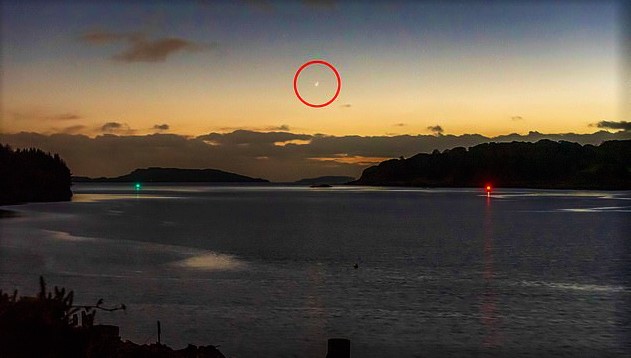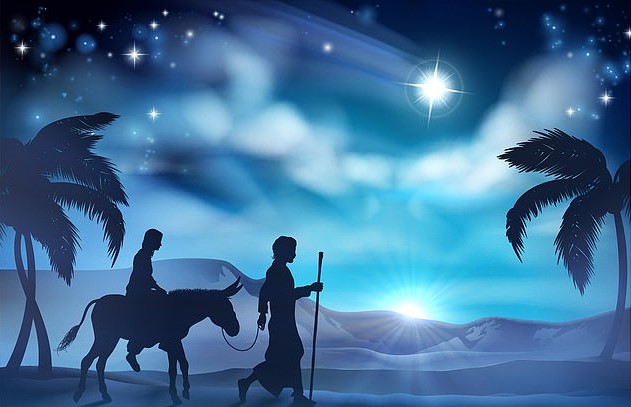Jupiter and Saturn appeared closer to each other in the night sky tonight than they have in 800 years — forming a celestial beacon akin to the ‘Star of Bethlehem’.
The gas giants — the largest planets in the solar system — have been slowly getting closer in the sky since the summer, and appeared like a double planet system.
Coinciding with the Winter Solstice, the conjunction could be viewed by eye from anywhere on Earth.
The planets looked around a fifth of a full moon’s width apart earlier tonight — appearing low above the horizon in the UK — and can be seen for the rest of the week until Christmas Day.
The German astronomer Johannes Kepler wrote in 1614 that he believed the ‘star of Bethlehem’ in the Nativity story may have been a conjunction of Jupiter and Saturn.
Others researchers have suggested instead that the ‘three wise men’ may have followed a triple conjunction of Jupiter, Saturn and Venus.
While Venus won’t be part of the this week’s conjunction, it will still be an impressive astronomical site — one best viewed on the equator, but visible worldwide.
The event comes in a busy week for stargazers, with the Ursid meteor shower — the last for this year — peaking tonight and continuing into early tomorrow morning.
At its height, the shower will produce around five shooting stars an hour, which will burn up as they pass through the atmosphere at around 36 miles per second.
Like the conjunction, the Ursids will be visible to the naked eye — but will most easily seen in areas with little light pollution.
Astrophysicist Megan Argo of the University of Central Lancashire told BBC Radio 4 Today that the event was highly unusual.
‘The best way to look is to go outside after sunset, by the time the sky has gone a bit dark and Jupiter should be the first thing you see in the night sky after the moon,’ she explained.
The view will be best, Dr Argo added, from places with a good western horizon — clear of trees and buildings.
Those in London and New York saw the planets close to the horizon — at around 5.3° and 7.5°, respectively — around an hour after the sun sets tonight.
‘Alignments between these two planets are rather rare, occurring once every 20 years or so,’ said astronomer Patrick Hartigan of Rice University of Houston, Texas.
‘But this conjunction is exceptionally rare because of how close the planets will appear to one another,’ he explained.
‘You’d have to go all the way back to just before dawn on March 4, 1226, to see a closer alignment between these objects visible in the night sky.’
A similar conjunction also occurred in 1623 — but at this time, the planets would have only been visible during the day, making them very difficult to see.
The next time that Jupiter and Saturn will seem as close in the sky will not be until March 15, 2080 — when they will be higher in the sky and visible for longer.
The next such conjunction of the two bodies after that will not be until sometime after the year 2400.
‘On the evening of closest approach on Dec 21 they will look like a double planet, separated by only 1/5th the diameter of the full moon,’ Professor Hartigan added.
‘For most telescope viewers, each planet and several of their largest moons will be visible in the same field of view that evening.’
While Kepler thought a conjunction of Jupiter and Saturn was behind the ‘star of Bethlehem’ story in the bible, others believed that it may have been another astronomical event — such as a large comet in the sky.
Professor Hartigan said that the planetary duo would appear low in the western sky around sunset — and would be bright enough to be viewed in the twilight sky.
In reality the two planets are still millions of miles apart — Jupiter is about 5AU from the Earth (one AU is the distance of the Earth from the Sun) and Saturn is 10AU away from the Earth — but they appear together due to differences in their orbit.
‘The further north a viewer is, the less time they’ll have to catch a glimpse of the conjunction before the planets sink below the horizon,’ Professor Hartigan explained.
‘By the time skies are fully dark in Houston, for example, the conjunction will be just 9 degrees above the horizon,’ he added.
‘Viewing that would be manageable if the weather cooperates and you have an unobstructed view to the southwest.’
Onlookers with a telescope who viewed the conjunction earlier tonight not only saw Jupiter and Saturn, but also some of their largest moons in the same field of view, astronomers have said.

